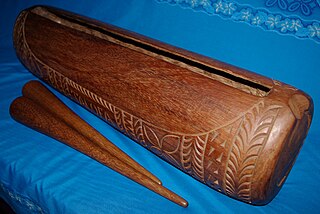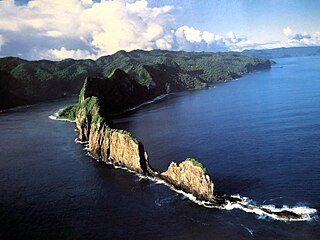Related Research Articles

Samoan is a Polynesian language spoken by Samoans of the Samoan Islands. Administratively, the islands are split between the sovereign country of Samoa and the United States territory of American Samoa. It is an official language, alongside English, in both jurisdictions. It is widely spoken across the Pacific region, heavily so in New Zealand and also in Australia and the United States. Among the Polynesian languages, Samoan is the most widely spoken by number of native speakers.

The traditional music of Tuvalu consists of dances, including fatele, fakanau and fakaseasea. The influence of the Samoan missionaries sent to Tuvalu by the London Missionary Society from the 1860s resulted in the suppression of songs about the traditional religions or magic and many songs were lost. As the influence of the missionaries diminished in the 20th century the traditional dances were revived and the siva dance tradition from Samoa also became popular.

The music of Tokelau occurs in the atolls of Atafu, Nukunonu, and Fakaofo. It is dominated by communal choral activity in harmony, with percussive accompaniment including log drums (pate), pokihi and apa. Nukunonu is notable for traditional song and dance.

Taʻū is the largest inhabited island in the Manuʻa Islands and the easternmost volcanic island of the Samoan Islands. Taʻū is part of American Samoa. In the early 19th century, the island was sometimes called Opoun.
The traditional culture of Samoa is a communal way of life based on Fa'a Samoa, the unique socio-political culture. In Samoan culture, most activities are done together. The traditional living quarters, or fale (houses), contain no walls and up to 20 people may sleep on the ground in the same fale. During the day, the fale is used for chatting and relaxing. One's family is viewed as an integral part of a person's life. The aiga or extended family lives and works together. Elders in the family are greatly respected and hold the highest status, and this may be seen at a traditional Sunday umu.

Rainmaker Mountain is the name of a mountain located near Pago Pago, American Samoa on Tutuila Island. Rainmaker Mountain traps rain clouds and gives Pago Pago the highest annual rainfall of any harbor. The average annual rainfall on the mountain is around 200 inches (510 cm). It has a three-pronged summit. Rainmaker Mountain and its base were designated a National Natural Landmark in 1972 due to the slopes’ tropical vegetation.

The Roman Catholic Mission Sui Iuris of Tokelau in Tokelau is a suffragan mission of the Roman Catholic Archdiocese of Samoa-Apia. It was formed in 1992 when the Archdiocese of Samoa-Apia and Tokelau was split into the Archdiocese of Samoa-Apia and the Mission Sui Iuris of Tokelau. The position of Ecclesiastical Superior is currently vacant following the death of Archbishop Alapati Lui Mata’eliga on 25 April 2023.
White Sunday,, is a national holiday in Samoa falling on the second Sunday of October, with the Monday following a public holiday. It is also celebrated in American Samoa, Tokelau and Tonga.
Fagaʻalu is a village in central Tutuila Island, American Samoa. It is also known as Fagaʻalo. It is located on the eastern shore of Pago Pago Harbor, to the south of Pago Pago. American Samoa's lone hospital, Lyndon B. Johnson Tropical Medical Center, is located in Fagaʻalu. The village is centered around Fagaalu Stream.
Rugby union is a popular sport in Tokelau.
The Maulu'uluis an indigenous dance performed by the Samoan people. Contemporary ma'ulu'ulu compositions and choreographies are generally performed by female dancers, although some villages have a tradition of men and women dancing together. The maulu'ulu was one of several dance forms and choral song styles that were brought into the Kingdom of Tonga through cultural diffusion in the late nineteenth century. Considerable divergence of technique and choreography now differentiate the Samoan maulu'ulu from the Tongan Ma'ulu'ulu, although their common origin continues to be celebrated.
A fakanau is a traditional Tuvaluan male dance, accompanied by singing and rhythmic clapping.

The fatele or faatele is a traditional dance song of Tuvalu. Dancing songs are the most common type of traditional Tuvaluan song, with other traditional dance styles including fakanau and fakaseasea.
Even Hovdhaugen was a Norwegian linguist. He became a professor of general linguistics at the University of Oslo in 1974. He was an expert in Polynesian languages.
Taʻū County is a county in the Manu'a District in American Samoa. Taʻū County is home to the villages of Lumā and Siʻufaga, which are commonly jointly called Taʻū Village.
Ottoville is a subdivision or district within the village of Tafuna, American Samoa.
Satala is one of Pago Pago’s constituent villages and is located in Pago Pago Bay on Tutuila Island. Satala is in Maoputasi County in the Eastern District of the island. It is home to the historic Satala Cemetery, which is listed on the U.S. National Register of Historic Places, and the government-owned Ronald Reagan Marina Railway Shipyard.

Pola Island is an island just offshore from the village of Vatia on Tutuila Island in American Samoa. It is also known as Cockscomb. Pola Island is designated as part of the National Park American Samoa and is a popular tourist attraction. It is located on the west side of Vatia Bay, and serves as both a landmark and an icon for Vatia. Pola Island has been named one of American Samoa's Seven National Wonders by the Pago Pages. It has been named "the most beautiful natural feature of Tutuila Island” by travel guide publisher Lonely Planet. Pola Island is known for its high cliffs, populated by seabirds, and is one of American Samoa's primary seabird nesting sites.
Tia Seu Lupe is a historical site at Fatuoaiga, American Samoa, which is maintained by the American Samoa Department of Parks and Recreation. The Tia Seu Lupe Historic Monument was dedicated by Governor Peter Tali Coleman in May 1990. It is located on a 0.2 ha plot of land on the Tafuna Plain which has been leased by the Government of American Samoa. The monument exhibits a stone structure which archeologists believe were platforms constructed for the chiefly sport of pigeon catching. The name "Tia Seu Lupe" literally means "earthen mound to catch pigeons".
A fatupaepae is a matriarchal senior figure in the culture of Tokelau. Fatupaepae groups are village-level women's organizations in Tokelau, with one such group in each atoll of the island territory: Atafu, Nukunonu, and Fakafo.
References
- ↑ Pratt 1893, pp. 158.
- ↑ Hoëm 2015, p. 197.
- ↑ Hoëm, Hovdhaugen & Vonen 1992, p. 26.
- ↑ Hoëm 2015, p. 26.
- ↑ TPIE 2000, p. 499.
- ↑ Atkinson, Rawlings-Way & Sheward 2016, p. 323.
Reference bibliography
- Hoëm, Ingjerd (2015). "Ritualized performances as total social facts: The house of multiple spirits in Tokelau". Ritual Communication. Wenner-Gren International Symposium Series. Taylor & Francis. ISBN 9781474248112.
- Pratt, George (1893). A Grammar and Dictionary of the Samoan Language: With English and Samoan Vocabulary. Religious Tract Society.
- Hoëm, Ingjerd; Hovdhaugen, Even; Vonen, Arnfinn Muruvik (1992). Tokelau Oral Literature. Scandinavian University Press. ISBN 978-82-00-21650-6.
- Lal, Brij V.; Fortune, Kate, eds. (2000). "Dance on Tokelau". The Pacific Islands: An Encyclopedia. Vol. 1. University of Hawaii Press. ISBN 9780824822651.
- Atkinson, Brett; Rawlings-Way, Charles; Sheward, Tamara (2016). Lonely Planet Rarotonga, Samoa & Tonga. Lonely Planet. ISBN 9781786577313.